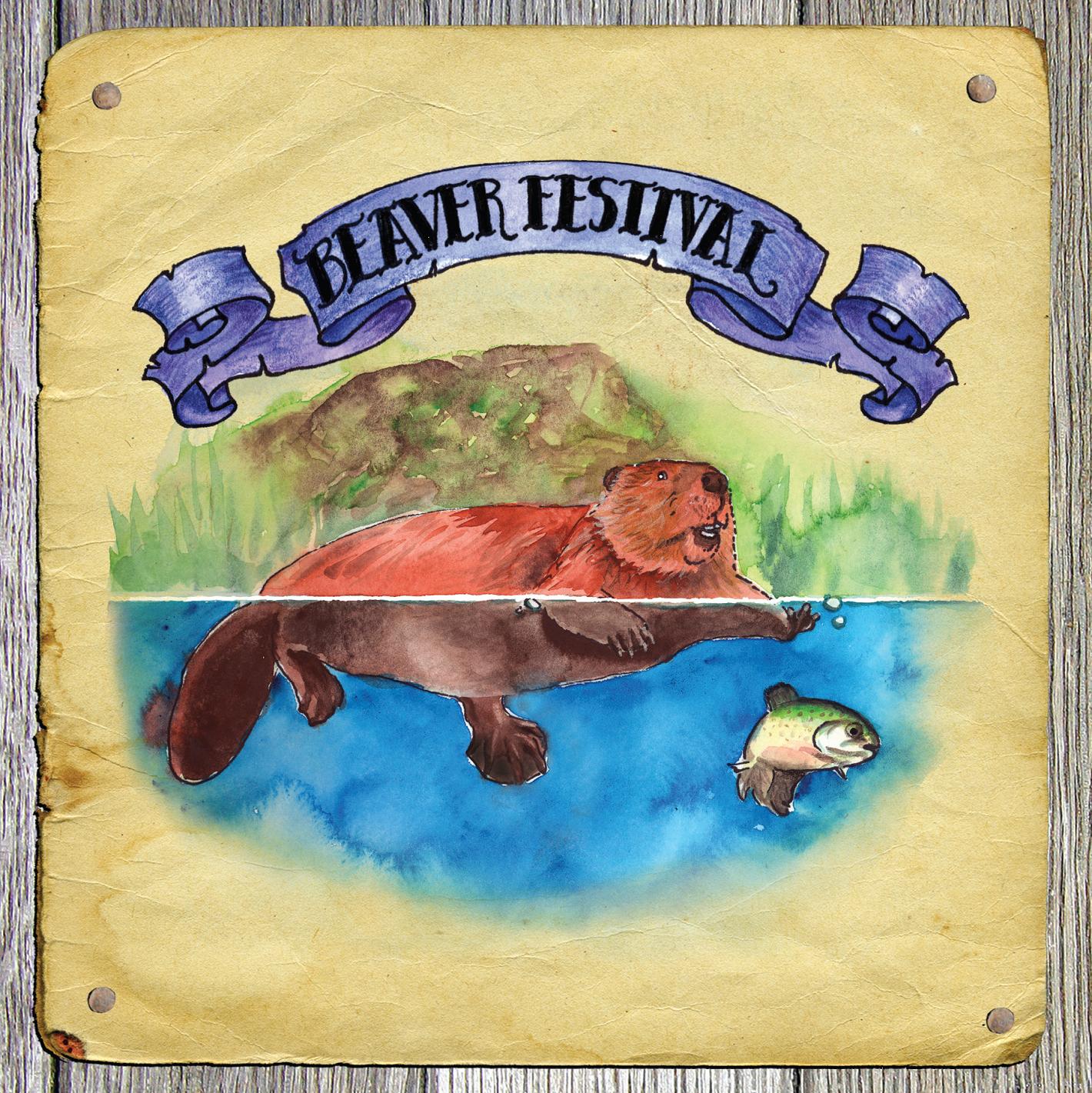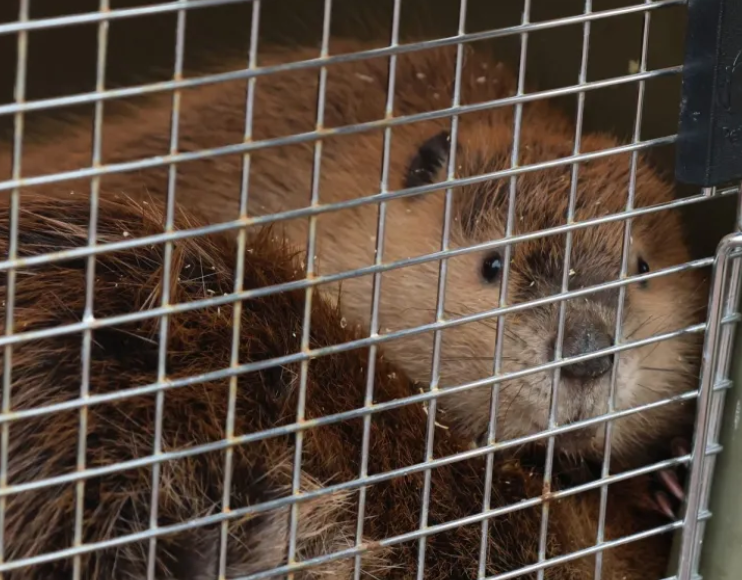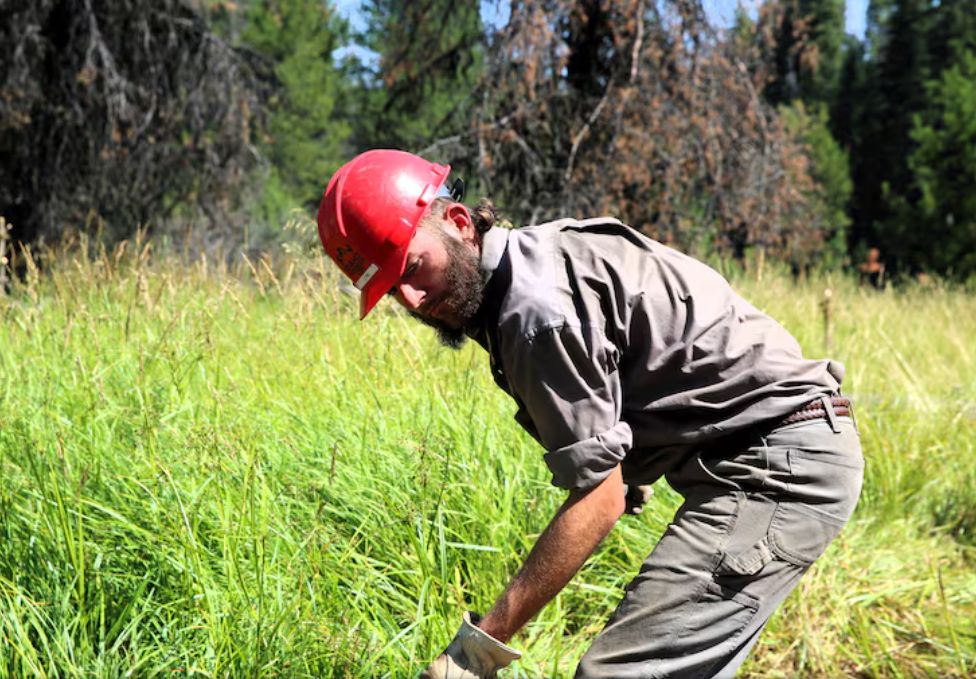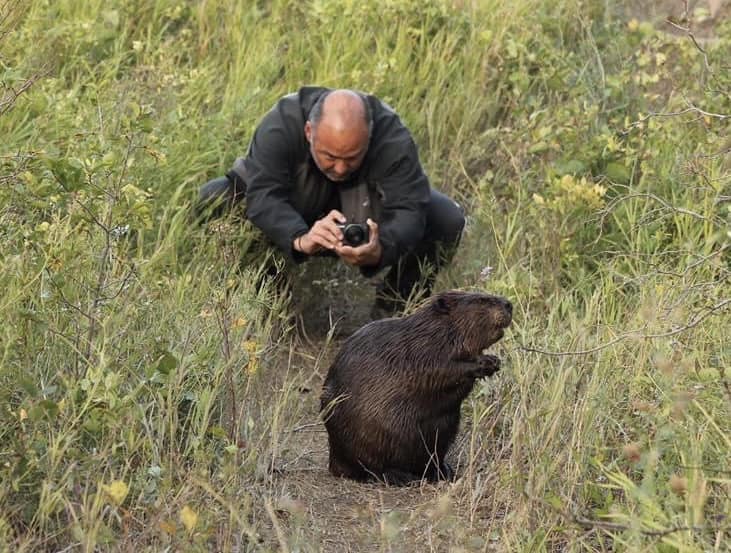Month: September 2024
I am as fond of this photo as any I’ve ever seen. There are a handful of people I have met in the past few years that have spent as much time a known family of beavers as I have. Mike Digout of Saskatchewan Canadan is one of them
You can see that beavers get to know their photographers fairly well over time.
This was a shuddering read from the California Water blog from nose to tail, I am sure the increase of beaver can positively boost the increase of native fish, but maybe it comes too late.
Watching native fishes vanish
By Andrew L. Rypel and Peter B. Moyle
 It’s an odd, disturbing feeling – watching populations of native fish species collapse and then disappear. Sometimes it happens quickly, other times it’s a series of slowstep change events. The end result is the same though – smaller populations, extinctions, less biodiversity. We put up a little fight, and occasionally have moderate success. But by and large, the overall trend is down, the pace of change quickening, and it is relentless.
It’s an odd, disturbing feeling – watching populations of native fish species collapse and then disappear. Sometimes it happens quickly, other times it’s a series of slowstep change events. The end result is the same though – smaller populations, extinctions, less biodiversity. We put up a little fight, and occasionally have moderate success. But by and large, the overall trend is down, the pace of change quickening, and it is relentless.
Wait, what? Loosing sturgeon and sticklebacks and salmon and Tule Perch and all those little fish that I was so surprised to learn about along the way?
California White Sturgeon Decision. On June 19, the California Fish & Game Commission voted that the petition to list White Sturgeon as “threatened” under the California Endangered Species Act was warranted. The species is not listed yet, but rather, now enters a one-year review period to determine a formal listing status. The data presented by CDFW to the Commission supports the need for increased protection. We wrote blogs about the sturgeon situation over the past two years as the situation worsened (Schreier et al. 2022, Moyle and Rypel 2023). Two major lines of evidence supporting listing include: 1) Massive decline in White Sturgeon numbers, as we have measured them over time; and 2) A mass die-off of sturgeon coincident with the red tide event two summers ago. This event killed a substantial fraction of the population, but we don’t really know how many, just a lot….Ultimately, sturgeon as a group have survived for hundreds of millions of years, but they don’t currently seem to be surviving us.
Ompf. Okay but that’s just one kind of fish. Maybe the rest of the picture looks better, right?
Longfin Smelt Listing. On July 30, the United States Fish and Wildlife Service published a rule in the Federal Register listing the San Francisco Bay-Delta distinct population segment of Longfin Smelt (Spirinchus thaleichthys) as endangered under the United States Endangered Species Act (US ESA). The Longfin Smelt is a close relative of the Delta Smelt (Hypomesus transpacificus), which has a long history of decline and political battles in California, but is essentially extinct in the wild. The Longfin Smelt differs from Delta Smelt in geographic distribution (occurs all the way north to Alaska, while Delta Smelt occur only in the San Francisco Estuary), but also life-history, feeding, and apparent patterns in anadromy (Hobbs et al. 2019, Lewis et al. 2020, Barros et al. 2022). San Francisco smelt populations have been in severe decline for years, primarily because the Delta ecosystem itself is in decline (Hobbs et al. 2017). Thus, formal listing of Longfin Smelt only confirms from a protective and regulatory standpoint, the tough reality that biologists have long struggled with.
When Peter Moyle tells you you’re running out of fish, you best pay attention.
The near-complete collapse of spring-run Chinook salmon in California is actually incredible. These fish were once codominant with fall-run Chinook salmon in the Central Valley (Yoshiyama et al. 1998). Total annual abundance of spawners was 600,000 adults during the late 1800s, but reduced to an average of around 10,000 fish in the 1960s. Numbers stayed near this level until just a few years ago (Rypel et al. 2021). Just three streams now sustain stronghold non-heterozygote populations of spring-run Chinook salmon: Deer Creek, Mill Creek, and Butte Creek. For many years, these streams (despite water diversion and other issues) were considered model ecosystems, resilient to effects of climate change and human impacts because of an abundance of cold water and forested watersheds. Yet numbers collapsed further in the last two years. According to numbers published in CDFW’s “GrandTab” Database, last summer the total number of adults in Deer, Mill, and Butte Creeks were just 23, 34, and 95 salmon, respectively (Azat 2024). This prompted a relocation of some of these juveniles to UC Davis in an emergency attempt to start a captive broodstock. And this year the adult numbers, currently unpublished, appear to be similar. A reintroduction effort of spring-run on the San Joaquin River is ongoing.
It doesn’t matter that we won the beaver fight with the USDA because of salmon if we don’t have any salmon left for beavers to help.
Speckled Dace Listings. On 8/7, the USFWS published in the Federal Register that the Long Valley Speckled Dace is now a candidate species for listing under US ESA. For many years, Speckled Dace was considered to be a single species from Canada to Mexico, but research at UC Davis Center for Watershed Sciences revealed that there was great cryptic diversity within these fishes (Moyle et al. 2023). There are three Speckled Dace species now recognized in California. These include the Santa Ana Speckled Dace (Rhinichthys gabrielino, described in more detail below), the Desert Speckled Dace (Rhinichthys nevadensis), and the Western Speckled Dace (Rhinichthys klamathensis). The Long Valley Speckled Dace is a subspecies of Desert Speckled Dace (Rhinichthys nevadensis caldera) (Moyle et al. 2023). This fish is currently found in just one spring east of Mammoth Lakes – uniquely enough, in the direct outflow from a public swimming pool that is fed by a hot spring. It is one of the rarest and most vulnerable endemic fishes in California. We know very little about its biology and life-history, and its continued existence hinges on attention to the water supply and to the population recently established in an artificial pond where old tires are the principal cover provided for the fish…These findings prompted the petition by the Center for Biological Diversity to USFWS to list the species. It is feared that, if nothing is done, the species may go extinct in 50 years or less.
How does this happen? How do we so squander our streams in California that there is no way to reverse the damage?
Conclusion: An Unambiguous Signal. None of these recent developments are surprising. Freshwater biodiversity is collapsing globally, and extinction rates are far higher in freshwater ecosystems versus terrestrial ones (Ricciardi and Rasmussen 1999). This pattern has been playing out for some time in California, with the number of stable species declining and the number of endangered species increasing (Fig. 4). At least 83% of California’s native fishes are currently at risk of extinction (Moyle et al. 2011). 78% of salmonids are projected to go extinct in the next century (Katz et al. 2013, Moyle et al. 2017). These losses are harmful to Indigenous cultures in multiple ways, and the loss of salmon changes the ecology of our riparian forests, which were historically fertilized by salmon carcasses.
The list of consequences include birds, includes otters, includes the health and character of fresh water in California from one end to the other as far as the eye can see.
When we lose species, it speaks volumes about our inability to prevent ecosystem decline, and to constantly borrow from nature without repayment (Rypel 2023). The pattern is especially sobering with charismatic species such as Chinook salmon, which receive large amounts of conservation funding and attention. This is a clear and unambiguous signal that cannot be ignored. But what should we do about it? A good start might be the development and implementation of a comprehensive fish management plan for California. We provided some scaffolding for what such a plan might look like in a previous blog. The 30×30 conservation goal of the Resources Agency can boldly protect many declining fishes if fully implemented. This initiative seeks to directly protect entire watersheds, including where many declining fish occur.
Okay Whatever you say, well do it. We have to try something, right?
It shows that despite our best intentions and previous efforts to manage fallout, we have not solved the grand challenge of how to pursue economic growth while also sustaining ecosystems. California is a globally important biodiversity hot spot, and fish are just one part of its highly distinctive biota. Our goal should be to lead the world in showing how we can make our distinctive, rich economy compatible with our astonishing biotic heritage.
BOOM. Yes it should. Our goal should be to have so many rich restored streams tended by healthy populations of restored beavers that native fish have  all the food and clean water they need.
all the food and clean water they need.
Beavers can help. Let them help,
Giving troublesome beavers a second chance
 These beavers are part of the Beaver Translocation Program and are the third group this year to be relocated from the Valley floor to the Rio Grande National Forest. “Problem” or “nuisance” beavers are more often than not, just killed. When their dam building collides with agriculture or when they are perceived to be displacing water levels or threatening water rights, beavers are seen as pests and are treated as such. The hope is that this program will eventually lead to less conflict and more coexistence.
These beavers are part of the Beaver Translocation Program and are the third group this year to be relocated from the Valley floor to the Rio Grande National Forest. “Problem” or “nuisance” beavers are more often than not, just killed. When their dam building collides with agriculture or when they are perceived to be displacing water levels or threatening water rights, beavers are seen as pests and are treated as such. The hope is that this program will eventually lead to less conflict and more coexistence.
The future, Reese and Born say, is coexistence.
The Beaver Translocation Program is a part of the Rio Grande National Forest Wet Meadows Restoration Project. The Rio Grande Headwaters Restoration Project and the Forest Service have partnered on a new pathway for beavers to be placed higher in the mountains where they can have more direct influence on the watersheds and avoid the nuisance label. Projects like these have sprung up over the United States and in Canada, but work really didn’t start in Colorado until about two years ago.
“There’s always going to be conflicts on the Valley floor,” said Born, stewardship coordinator for the Rio Grande Headwaters Restoration Program. “I think of this as much a service to irrigators and water rights holders in the Valley as it is a benefit to the forest.”
Beavers play a vital role in watershed health; their impacts on the environment as a whole are widespread and well-known. However, where beavers excel in some places, they can be real problems in others. Particularly on the Valley floor, where their work and the work of farmers and ranchers collide.
Every beaver relocation article is a little bit treacherous. Opportunities for shudders and successes. What will this hold?
 Reese and Born, with two adult beavers, two yearlings and a kit, load into a Forest Service truck and drive the length of the Valley until they are high in the Rio Grande National Forest. For those few hours, the five beavers traveled faster and further than they ever have before.
Reese and Born, with two adult beavers, two yearlings and a kit, load into a Forest Service truck and drive the length of the Valley until they are high in the Rio Grande National Forest. For those few hours, the five beavers traveled faster and further than they ever have before.
Beavers are nature’s engineers, second perhaps only to humans. Yet there is an age-old tension between us and them that has forced us to think differently about what techniques can reduce conflicts and make sure that the Rio Grande National Forest’s watersheds and the Rio Grande stay healthy.
Overgrazing and drought are two factors at play that threaten watersheds and streams. The relocated beavers will call the Rios de los Piños home and even though their future is somewhat cloudy, they have been given another shot at life and an opportunity to do their jobs.
If there’s enough habitat, they’ll stay together as a multi-generation family unit. But if there’s limited food or habitat they’ll move away.
At the release site, Reese and Born pull on their waders. Reese comforts the beavers who at this point have huddled into the corners or against the gates of the kennels, eyes wide and hearts racing.
The best part of this article is that it clearly emphasizes why beavers matter to stream health and water storage. And how if you get one family of nuisance beavers you are likely to get more.
In the meadows that beavers occupy, their dams act like sponges, soaking up water and dispersing it far and wide. Born said, “You have this whole mini-aquifer of groundwater that if the beaver dam is there is just full. And that sponge is going to help release water longer into the season and keep the river wet. It’s just the same as the Rio Grande and the aquifers here.”
There’s a direct relationship between beavers and water health.
Born said that would entail installing groundwater transducers and streamflow gauges before and after one of these restoration projects. That has never really occurred in the San Luis Valley before. The hope, he said, is to show that they are either increasing flows or doing very little.
Groundwater traducers. I’ve been looking for that term forever! The New Mexico Beaver Summit said that these tools were key to helping landowner understanding how beaver could help them even if they appeared to be altering stream flow. They needed to know the water wasn’t GOING away just because they couldn’t see it anymore.
All of these precautions are taking place because Reese and Born want to see these animals thrive and they want to ensure the health of the environment. Again, beavers are second only to humans in their ecosystem engineering. They are the water’s guides, and despite their conflict with humans, are a keystone species that we would sorely miss.
What comes out of this program has yet to be seen, but it’s promising. Whatever data and answers can be drawn will be shared for years to come.
Even if the success rate is 30 to 50 percent and not every beaver released doesn’t make it, Reese said she still feels “like the effort we’re putting in is worthwhile for the potential benefits of having more beaver on the landscape.”
Um,,,No. 30 percent survival rate is not okay. Especially if you make the job of convincing farmers and ranchers that they need to cooperate with beavers 90% harder by telling them that there’s an easy way out.
I don’t think there’s any transducer that can measure that.
This was a fun read, Oh to be a college student working in the sun and sleeping on the ground for beavers!
These students are building dams over the summer — with hopes to lure beavers back
 Sheep Creek, a few miles west of La Grande, feeds the headwaters of the Grande Ronde River.
Sheep Creek, a few miles west of La Grande, feeds the headwaters of the Grande Ronde River.
Over the years, the area — nestled in the Wallowa–Whitman National Forest that encompasses northeastern Oregon and western Idaho — has been trapped for beavers, logged for timber and farmed for cattle. A group of a dozen young adults, from 18 to 28, just spent their summer trying to return the creek and its surrounding land to a more natural state.
“We’re making habitat for beavers,” said Luke Hurley, a forestry student at Southern Illinois University.
On one recent Wednesday, the crew pounded a row of six fence posts into the stream then threaded fir boughs in between. On top, they poured river rock and mud to weigh everything down and keep it in place. They were building, in essence, lots of little dams, known as beaver dam analogues.
“Normally, a beaver would do this,” Hurley said. “But hunting and stuff like that has just run them out.”
The hope is the beaver dam analogues will slow the river down by spreading it out across the valley, thereby creating a lush and marshy wetland.
Old said the ultimate goal is to attract real beavers, which has happened in similar projects downstream.
Now that’s the magic words. I never get excited about BDA articles unless I read them clearly. I just wish there was some kind of waiver people had to sign,
The work is funded by a mixture of private, state and federal money. For example, the U.S. Forest Service is helping because some of the creek is on its land. The same is true for the Bureau of Land Management. The Oregon Watershed Enhancement Board is spending lottery money on the project. And the Bonneville Power Administration is paying to mitigate for fish killed in its hydroelectric dams.
It’s a complicated and expensive program. But for the young people doing the work, like Luke Hurley, it feels simple and beneficial. He’s loving life outdoors, especially the way he can disconnect from society.
“You know there are societal standards and stuff. But out here, you’re living with the same people for weeks on end. They don’t care. I can just be myself out here,” Hurley said.
Other crew members are using the experience to make new connections, like Laura Potter, an environmental studies student at Boise State University, and Nina Heptig, an animation major at the School of Visual Arts in New York City.
I guess they applied for the position just like any work experience. Although I’m curious in how an artist from NY got hired.
 “I’d say that out of every other crew that we’ve been around, we like to talk to each other the most,” Heptig said. “We’ve been lucky on that front.”
“I’d say that out of every other crew that we’ve been around, we like to talk to each other the most,” Heptig said. “We’ve been lucky on that front.”
Heptig and Potter have spent the entire 10-week season together. They both saw elk for the first time and had a close encounter with a bear. One night, their tent was covered in ash from a nearby forest fire.
“I definitely crave purpose when I’m at home, and I think this does fulfill that sense of needing a purpose,” Potter said.
Participants each received a $6,000 stipend for 10 weeks of work plus another $1,800 in educational grants. Heptig and Potter have done the math. It works out to about $15 an hour.
And you get to work for beavers. Don’t forget that.
Meanwhile the Grande Ronde Model Watershed Council continues to oversee river improvements with the removal of old culverts and smaller dams. The hope is that in the future, more fish will be able to make the 600-mile migration out to the ocean and back again.








































